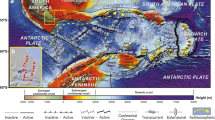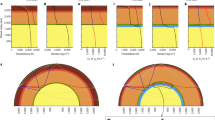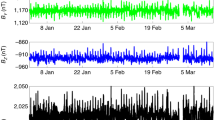Abstract
Since Mohorovičić1 discovered a dramatic increase in compressional seismic velocity at a depth of 54 km beneath the Kulpa Valley in Croatia, the ‘Moho’ has become arguably the most important seismological horizon in Earth owing to its role in defining the crust–mantle boundary. It is now known to be a ubiquitous feature of the Earth, being found beneath both the continents and the oceans, and is commonly assumed to separate lower-crustal mafic rocks from upper-mantle ultramafic rocks. Electromagnetic experiments conducted to date, however, have failed to detect a corresponding change in electrical conductivity at the base of the crust, although one might be expected on the basis of laboratory measurements2. Here we report electromagnetic data from the Slave craton, northern Canada, which show a step-change in conductivity at Moho depths. Such resolution is possible because the Slave craton is highly anomalous, exhibiting a total crustal conductance of less than 1 Siemens—more than an order of magnitude smaller than other Archaean cratons. We also found that the conductivity of the uppermost continental mantle directly beneath the Moho is two orders of magnitude more conducting than laboratory studies on olivine would suggest, inferring that there must be a connected conducting phase.
This is a preview of subscription content, access via your institution
Access options
Subscribe to this journal
Receive 51 print issues and online access
$199.00 per year
only $3.90 per issue
Buy this article
- Purchase on Springer Link
- Instant access to full article PDF
Prices may be subject to local taxes which are calculated during checkout




Similar content being viewed by others
References
Mohorovičić, A. Godisnje izvjesce zagrebackog meteoroloskog opservatorija za godinu 1909 1–56 (Zagreb, 1910) (in Croatian); Das Beben vom 8. X. 1909. Jahrb. Meteorol. Obs. Zagreb 9, Teil 4, Absch. 1, 1–63 (1910) (in German); The earthquake from 8th October 1909. Geofizika 9, 3–55 ( 1992) (in English).
Haak, V. in Numerical Data and Functional Relationships in Science and Technology Vol. 1, Subvol. b, Ch. 5, Sect. 4 (ed. Angenheister, G.) 291– 307 (Springer, Berlin, 1982).
Jones, A. G. in Continental Lower Crust Ch. 3 (eds Fountain, D. M., Arculus, R. & Kay, R. W.) 81–143 (Developments in Geotectonics 23, Elsevier, Amsterdam, 1992).
Gough, D. I. Seismic reflectors, conductivity, water and stress in the continental crust. Nature 323, 143–144 (1986).
Jones, A. G. MT and reflection: an essential combination. Geophys. J. R. Astron. Soc. 89, 7–18 ( 1987).
Yardley, B. W. D. Is there water in the deep continental crust? Nature 323, 111 (1986).
Frost, B. R. et al. Grain-boundary graphite in rocks and implications for high electrical conductivity in the lower crust. Nature 340, 134–136 (1989).
Yardley, B. W. D. & Valley, J. W. The petrologic case for a dry lower crust. J. Geophys. Res. 102, 12173–12185 (1997).
Jones, A. G. On the electrical crust-mantle structure in Fennoscandia: no Moho and the asthenosphere revealed? Geophys. J. R. Astron. Soc. 68, 371–388 (1982).
Ferguson, I. J. & Edwards, R. N. Electromagnetic mode conversion by surface-conductivity anomalies; applications for conductivity soundings. Geophys. J. Int. 117, 48– 68 (1994).
Jones, A. G. Imaging the continental upper mantle using electromagnetic methods. Lithos 48, 57–80 ( 1999).
Campbell, W. H. Introduction to electrical properties of the Earth's mantle. Pure Appl. Geophys. 125, 193–204 (1987).
Schultz, A., Kurtz, R. D., Chave, A. D. & Jones, A. G. Conductivity discontinuities in the upper mantle beneath a stable craton. Geophys. Res. Lett. 20, 2941– 2944 (1993).
Clowes, R. M. (ed.) LITHOPROBE Phase V Proposal (Lithoprobe Secretariat, Univ. British Columbia, Vancouver, 1997).
Stern, R. A. & Bleeker, W. Age of the world's oldest rocks refined using Canada's SHRIMP: The Acasta Gneiss Complex, Northwest Territories, Canada. Geosci. Can. 25, 27– 31 (1998).
Bleeker, W. et al. The Central Slave Basement Complex, Part I: its structural topology and autochthonous cover. Can. J. Earth Sci. 36, 1083–1109 (1999).
Jones, A. G. et al. A comparison of techniques for magnetotelluric response function estimation. J. Geophys. Res. 94, 14201 –14213 (1989).
McNeice, G. & Jones, A. G. Multisite, multifrequency tensor decomposition of magnetotelluric data. Geophysics (in the press).
Jones, A. G. Static shift of magnetotelluric data and its removal in a sedimentary basin environment. Geophysics 53, 967– 978 (1988).
Garcia, X. & Jones, A. G. Study of ionospheric sources for audiomagnetotelluric (AMT) sounding. Geophysics (submitted).
Parker, R. L. & Booker, J. R. Optimal one-dimensional inversion and bounding of magnetotelluric apparent resistivity and phase measurements. Phys. Earth Planet. Inter. 98, 269– 282 (1996).
Berdichevsky, M. N. & Dmitriev, V. I. in Geoelectric and Geothermal Studies (ed. Adam, A.) 165–221 (KAPG Geophysical Monograph, Akademiai Kiado, Budapest, 1976).
Fischer, G. & Le Quang, B. V. Topography and minimization of the standard deviation in one-dimensional magnetotelluric modelling. Geophys. J. R. Astron. Soc. 67, 279– 292 (1981).
Constable, S. C., Parker, R. L. & Constable, C. G. Occam's inversion: a practical algorithm for generating smooth models from electromagnetic sounding data. Geophysics 52, 289–300 (1987).
Parker, R. L. The inverse problem of electromagnetic induction: existence and construction of solutions based on incomplete data. J. Geophys. Res. 85, 4421–4425 (1980).
Cook, F. A. et al. Frozen subduction in Canada's Northwest Territories; Lithoprobe deep lithospheric reflection profiling of the western Canadian Shield. Tectonics 18, 1–24 ( 1999).
Viejo, G. F., Clowes, R. M. & Amor, J. R. Imaging the lithospheric mantle in northwestern Canada with seismic wide-angle reflections. Geophys. Res. Lett. 26, 2809–2813 (1999).
Bostock, M. G. Mantle stratigraphy and evolution of the Slave province. J. Geophys. Res. 103, 21183–21200 ( 1998).
Constable, S., Shankland, T. J. & Duba, A. The electrical conductivity of an isotropic olivine mantle. J. Geophys. Res. 97, 3397– 3404 (1992).
Olhoeft, G. Electrical properties of granite with implications for the lower crust. J. Geophys. Res. 86, 931–936 (1981).
Jones, A. G., Katsube, J. & Schwann, P. The longest conductivity anomaly in the world explained: sulphides in fold hinges causing very high electrical anisotropy. J. Geomagn. Geoelectr. 49, 1619–1629 (1997).
Acknowledgements
This work was performed under the auspices of Lithoprobe, Canada's national geoscience programme, funded by the Natural Sciences and Engineering Research Council of Canada and the Geological Survey of Canada. We thank the staff of Phoenix Geophysics Ltd for their attention to high-quality data acquisition.
Author information
Authors and Affiliations
Corresponding author
Rights and permissions
About this article
Cite this article
Jones, A., Ferguson, I. The electric Moho. Nature 409, 331–333 (2001). https://doi.org/10.1038/35053053
Received:
Accepted:
Issue Date:
DOI: https://doi.org/10.1038/35053053
This article is cited by
-
A review on developments in the electrical structure of craton lithosphere
Science China Earth Sciences (2020)
-
On the Causes of Electrical Conductivity Anomalies in Tectonically Stable Lithosphere
Surveys in Geophysics (2014)
-
Multi-station superposition for magnetotelluric signal
Studia Geophysica et Geodaetica (2013)
-
A simple method for deriving the uniform field MT responses in auroral zones
Earth, Planets and Space (2002)
Comments
By submitting a comment you agree to abide by our Terms and Community Guidelines. If you find something abusive or that does not comply with our terms or guidelines please flag it as inappropriate.



